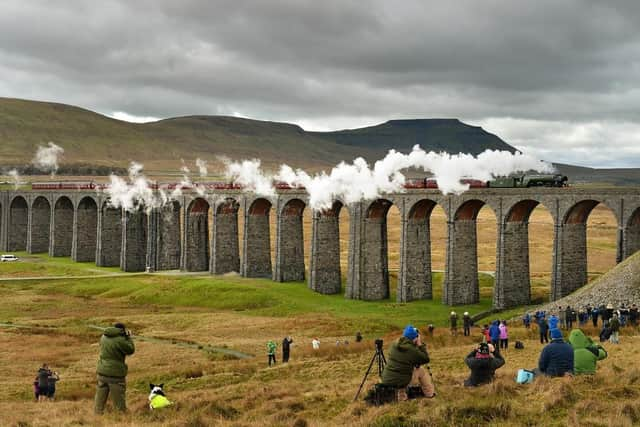Flying Scotsman 2023: History of the famous Yorkshire steam locomotive built in the early 20th century
The Flying Scotsman is a 4-6-2 Pacific steam locomotive which was built for the London and North Eastern Railway (LNER) at Doncaster Works and was designed by Nigel Gresley. Its official name is LNER Class A3 4472 Flying Scotsman and was employed on long-distance express East Coast Main Line trains.
It was also employed by its successors, British Railways Eastern and North-Eastern regions, including the London to Edinburgh Flying Scotsman train service, which it was named after. The Flying Scotsman has set two world records for steam traction; becoming the first steam locomotive to be officially authenticated as reaching 100 miles per hour (161 km/h) on November 30, 1934 and also setting the record for the longest non-stop run by a steam locomotive when it ran 422 miles (679 km) on August 8, 1989 when it was in Australia.
Advertisement
Hide AdAdvertisement
Hide AdIt retired from regular service in 1963 after running 2.08 million miles and was bought by Alan Pegler, William McAlpine, Tony Marchington and more recently National Railway Museum (NRM) while enjoying years of fame and preservation. Over the years, the locomotive has attracted thousands of tourists for every tour it makes.


The history of Yorkshire Flying Scotsman
The locomotive was built in Doncaster by LNER and went into service on February 24, 1923, making this year its 100th anniversary with number 1472 and was designed by Sir Nigel Gresley as part of the A1 class, said to be the most powerful locomotives used by the LNER at that time.
It cost £7,944 to build, weighs 97 tonnes and is 70ft in length. The locomotive was chosen to appear at the British Empire Exhibition in London by 1924 and was re-numbered 4472. It was the British Empire Exhibition that made Flying Scotsman famous and went on to feature in many more publicity LNER events.
It was given a new lease of life in 1928 with a corridor, meaning that a new crew could take over without stopping the train. This allowed it to haul the first ever non-stop London to Edinburgh service on May 1 that year, reducing the journey time to eight hours.
Advertisement
Hide AdAdvertisement
Hide AdThe Scotsman was sent out on a special test run and reached a speed of 100mph, making it officially the first locomotive in the UK to get to that speed. The test run proved that steam power could offer high speeds to LNER’s directors, making a plan for the company to use diesel power on its high-speed services ineffective.
Whilst LNER passenger locomotives had always been painted Apple Green, during the Second World War, the Flying Scotsman was re-painted black, symbolising wartime. After the war, it became green again and was rebuilt as an A3 Pacific.
British Railways was established in 1948 and rail travel in Britain was nationalised, by this time, the Flying Scotsman was numbered 60103 and was painted blue for some time, then BR Green and remained this colour until 1963, when it was retired by British Rail. It was bought by Alan Pegler at the beginning of that year.
It had already undergone numerous changes and alterations to improve its performance by this time but had been pulling trains for 40 years, when steam engines were becoming old fashioned.
Advertisement
Hide AdAdvertisement
Hide AdIt travelled from London King’s Cross to Edinburgh without stopping in May 1968 on its 40th anniversary of the first non-stop run. A year later, the Flying Scotsman travelled to the US on a tour intended to promote British exports and the tour broke-even in its first year, but lost money in its second.
Mr Pegler sent the train to San Francisco in a bid to balance the books, but ended up taking a turn for the worse financially; he was forced into bankruptcy and the Scotsman was abandoned in the US.
However, the locomotive was brought back to the UK in 1973 after William McAlpine heard about this and bought it. He put together a rescue plan and paid off the creditors. He had the engine recovered at Derby Works and kept it running for another 23 years in his ownership.
He even took Flying Scotsman to Australia, making it the first steam locomotive to circumnavigate the globe on its voyage and back. While it was in Australia in 1989, it also set a new record for the longest non-stop run by a steam locomotive.
Advertisement
Hide AdAdvertisement
Hide AdThe successful tour of Australia resulted in the locomotive running special trains around Britain, including regular services over the famous Settle to Carlisle Railway and trips hauling the prestigious Orient Express Pullman train.
It was repaired again in the early 1990s, by this time Pete Waterman formed a short-lived partnership with Sir William to run the locomotive and businessman Tony Marchington bought the Scotsman for £1.25 million in February 1996.
However, it ran into another disaster in 2004 over its ownership and a campaign organised by the NRM to save the locomotive for the nation garnered the support of thousands of people, confirming its status as a national treasure.
The appeal to keep the steam locomotive in Britain was also backed by a £1.8 million grant from the National Heritage Memorial Fund and the generosity of the public. The Heritage Lottery Fund also provided a grant of £275,000 for its restoration.
Comment Guidelines
National World encourages reader discussion on our stories. User feedback, insights and back-and-forth exchanges add a rich layer of context to reporting. Please review our Community Guidelines before commenting.
